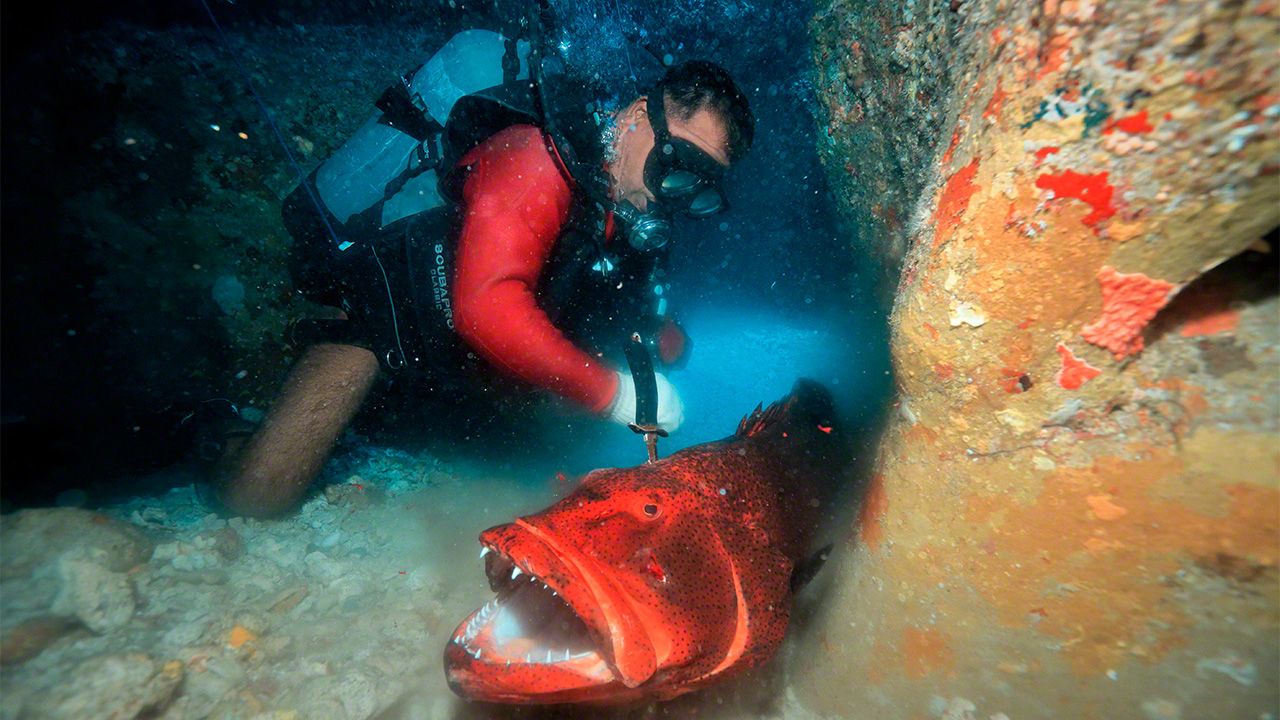
The Sea Hunter of Yaeyama: Uminchu Saburō
Environment Guide to Japan Society Culture Lifestyle- English
- 日本語
- 简体字
- 繁體字
- Français
- Español
- العربية
- Русский
Ishigaki Island is located approximately 400 kilometers southwest of Okinawa Island and 270 kilometers east of Taiwan. It is one of the subtropical Yaeyama Islands, along with Taketomi and Iriomote, and it has the most expansive coral reef in Japan.
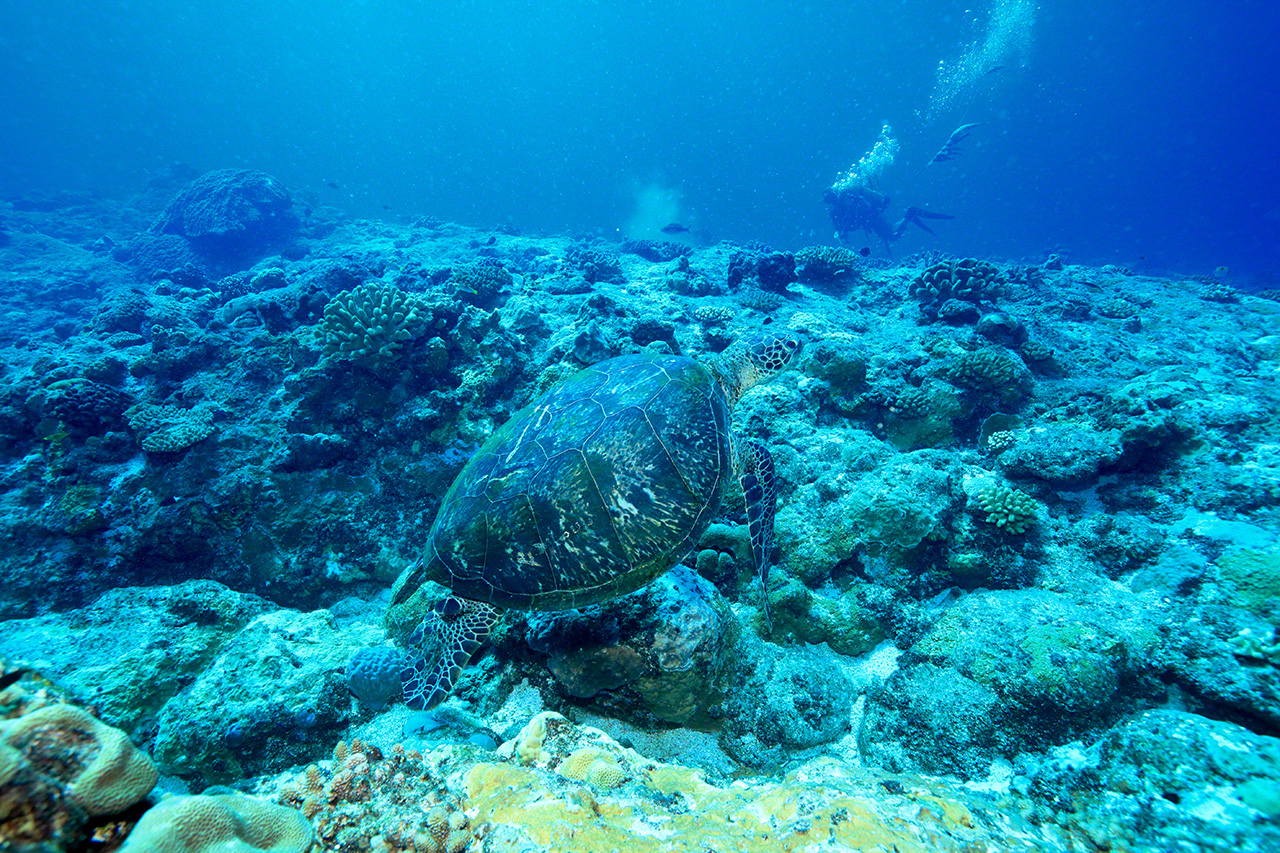
The Yaeyama Islands are home to large numbers of green sea turtles, which are frequently spotted by divers while fishing. (© Nishino Yoshinori)
To the divers known as uminchu, literally “people of the sea,” this coral reef and the open sea beyond is where they make their living. Ishigaki is home to approximately 300 uminchu and boasts one of the largest catches of fish in Okinawa Prefecture.
As many as 20 traditional fishing techniques are utilized, which underscores the diversity of the marine environment and its aquatic resources. Over the last hundred years or so the island’s fishing industry has incorporated drive-in net fishing and other dive fishing techniques due to the influence of divers from Itoman on the main island of Okinawa who worked on a temporary basis on the island. Since the waters around the island are warm and highly transparent, dive fishing is possible throughout the year.
Traditional Spearfisher
One of the people known for dive fishing is Shimoji Seiei, who is better known by his nickname “Uminchu Saburō.” The name “Saburō” comes from the fact that he is the third son in his family. While still a primary school student he made his own pole spear to catch fish and octopus. When he was just 17 he would drive his own boat to go diving for fish by himself.
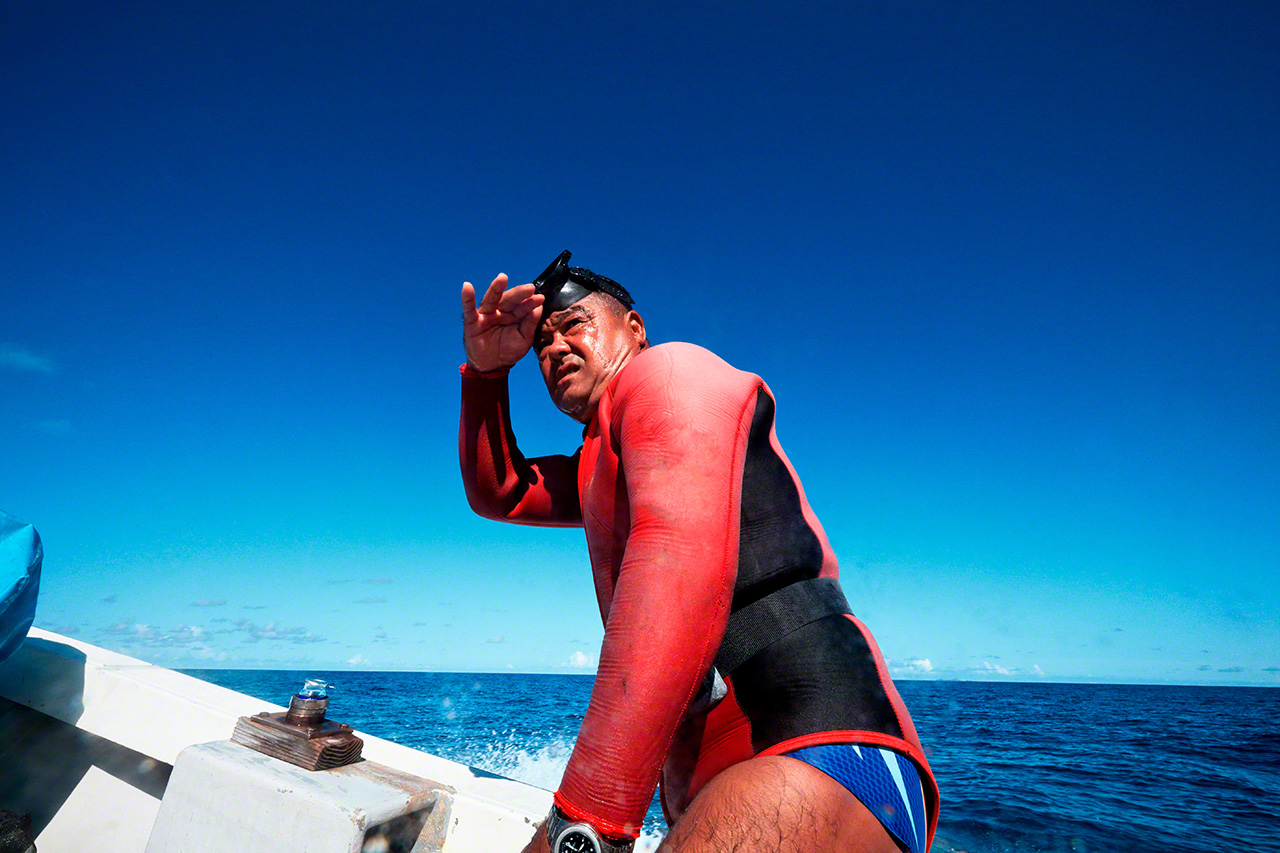
Uminchu Saburō searching for a good place to dive. He uses a technique known as yamatate to locate his position using a number of landmarks on shore. (© Nishino Yoshinori)
Uminchu Saburō fishes for tuna using the pole-and-line technique and he catches diamondback squid. He is most experienced, however, in dive fishing in the coral reef using pole spears and spearguns, techniques that distinguish him from other divers. He is also the last diver to use the traditional pole spear known as a naga-īgun, which measures five meters in length.

Fishing with a 5-meter spear known as a naga-īgun, one of the traditional fishing implements of Ishigaki and Miyako. (© Nishino Yoshinori)
The naga-īgun is mainly used for spearing a type of parrotfish known as the irabuchā that is found in the shallow areas of the coral reef in summer. The method used to catch these fish is simple: The diver free dives with the spear in hand, approaches the fish, and spears each one individually. He then repeats the process until his has caught his quota for the day. Divers can spend around six hours a day in the water when fishing.
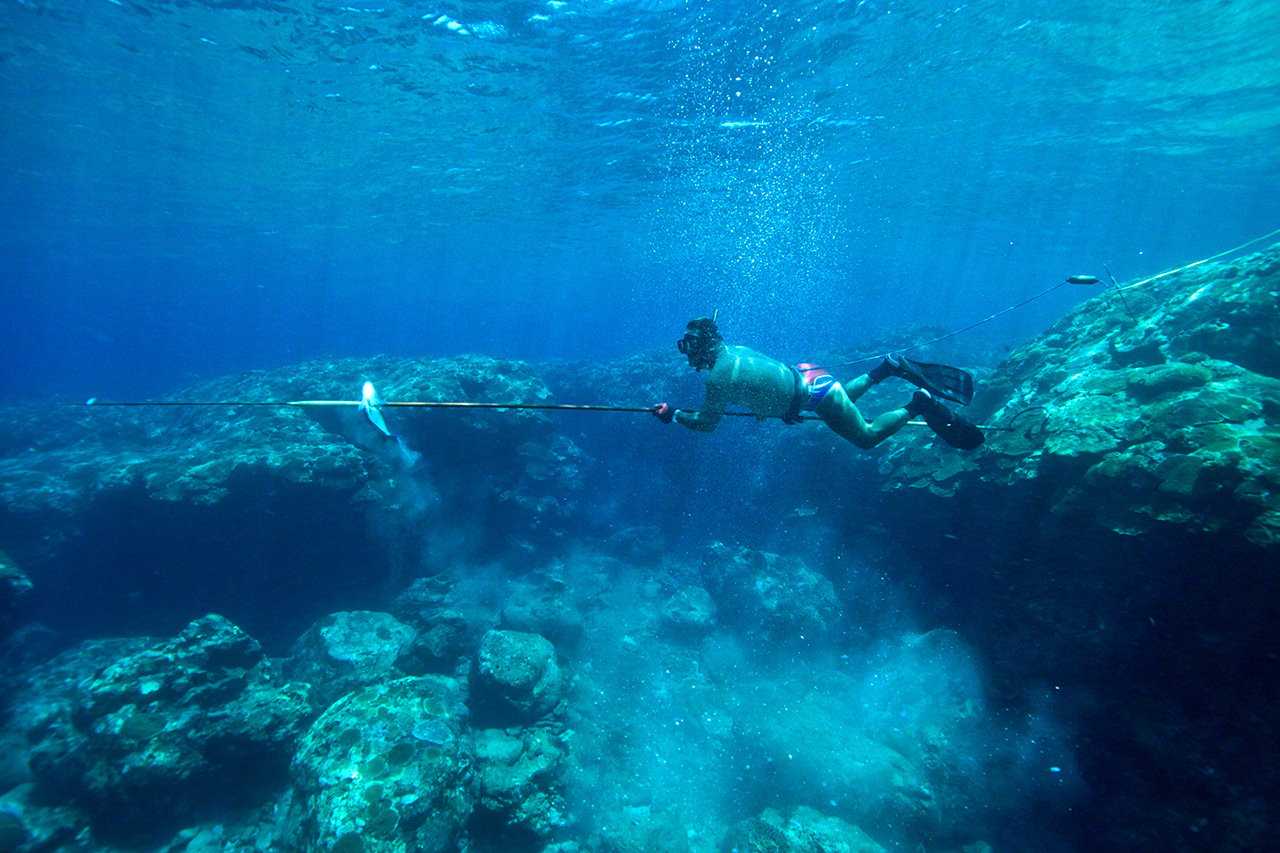
Spearing a Pacific steephead parrotfish with a naga-īgun. Since the spearhead has no barb, the diver must thrust the point deep into the fish. (© Nishino Yoshinori)
“I’m like a primitive man,” says Uminchu with a smile as his head breaks water after spearing a fish.
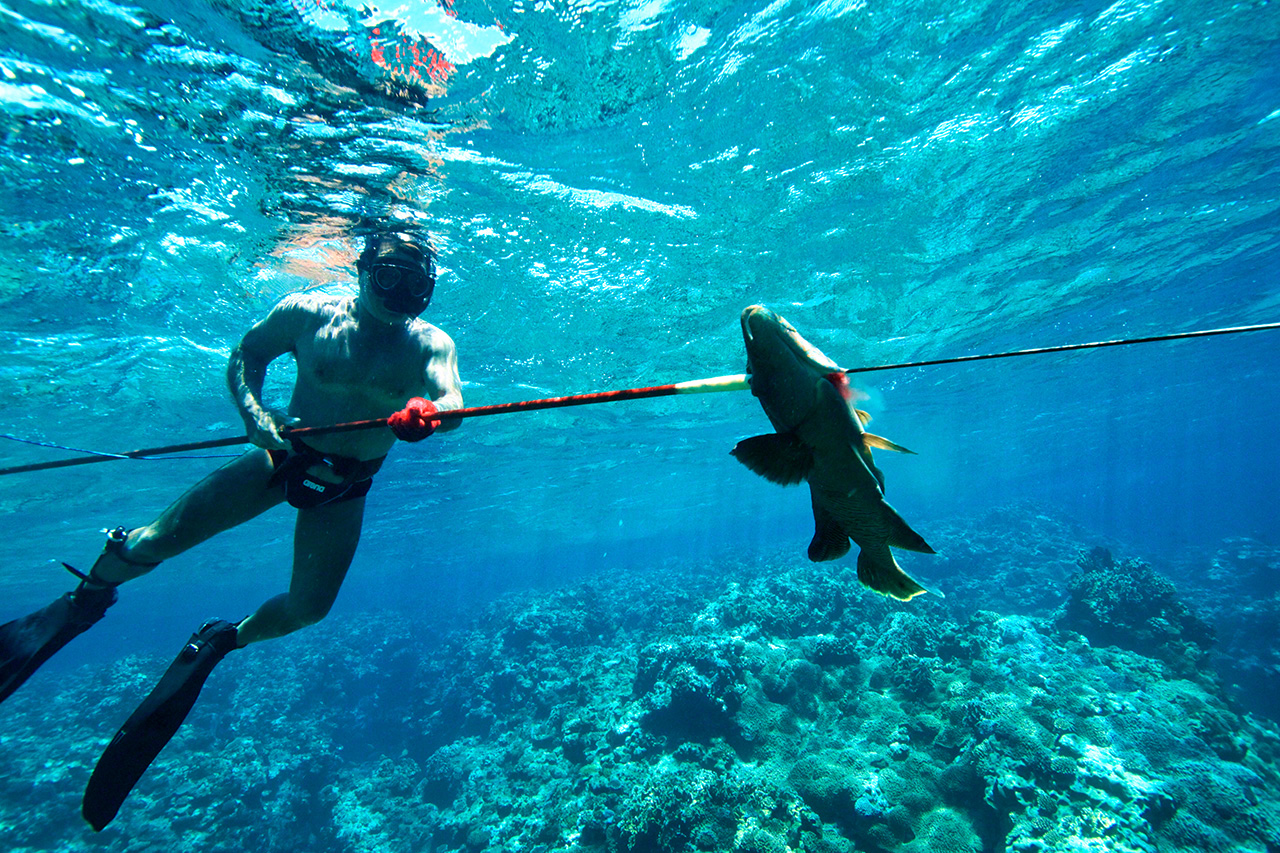
Spearing a humphead wrasse, a fish that is difficult to approach even when being extremely stealthy. It is an important commercial fish in Okinawa. (© Nishino Yoshinori)
He consistently performs with such expert skill that it looks to the layman like spearing fish is simple. But I experienced for myself just how difficult it is to swim within range of a target fish when I dove in the water with a spear in hand. The fish maintain their distance from the tip of the spear and read the movements of the diver. And even when one does manage to get within range, the target is restricted to the head of the fish, as spearing the body would damage the commercial part of the fish and thus reduce the price it will fetch. As a result, the target area measures only about five centimeters in size no matter how big the fish is. When amateurs try to spear a fish, they inevitably thrust the spear tip through the fish’s side, thus ruining the catch.
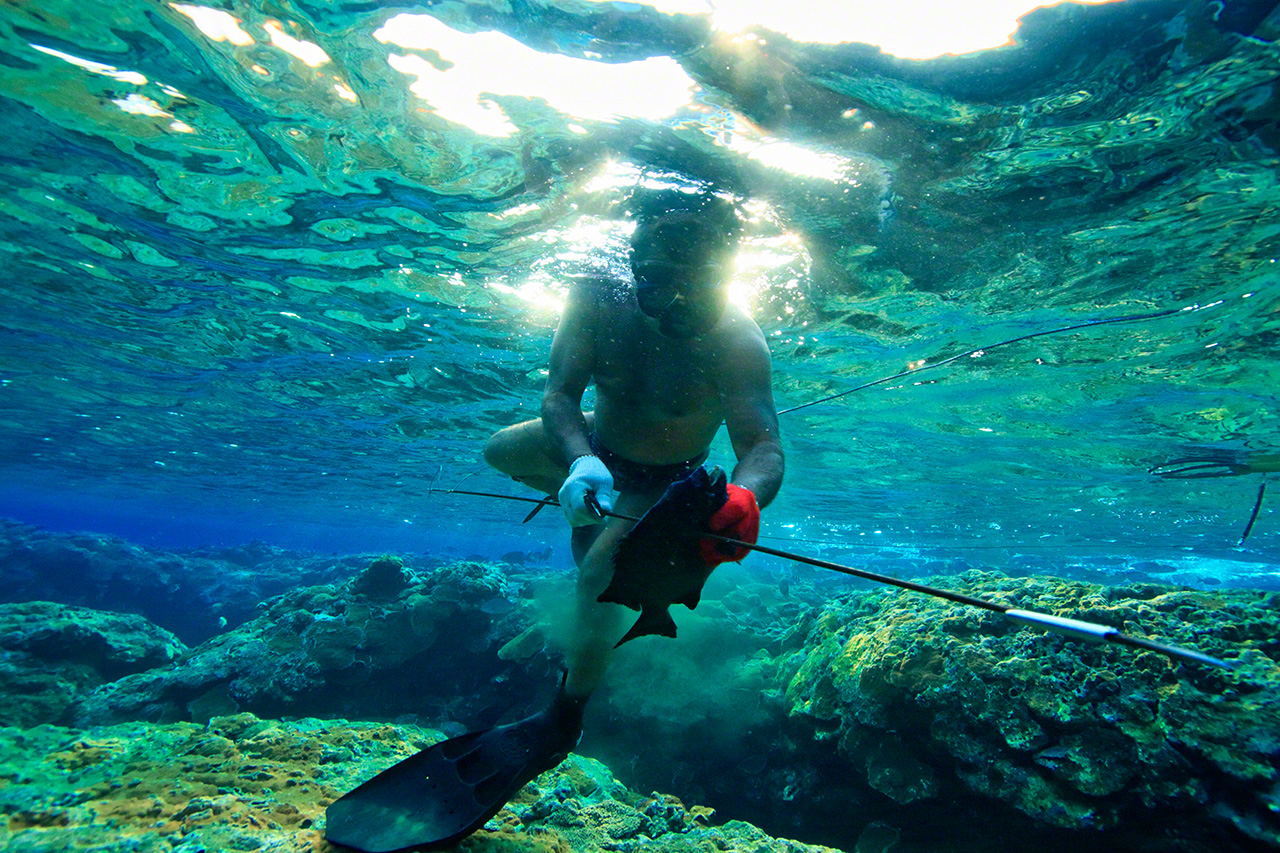
Spearing fish at daybreak. At this time of day the water is still only dimly lit as the sunlight reflects off the ocean surface. (© Nishino Yoshinori)
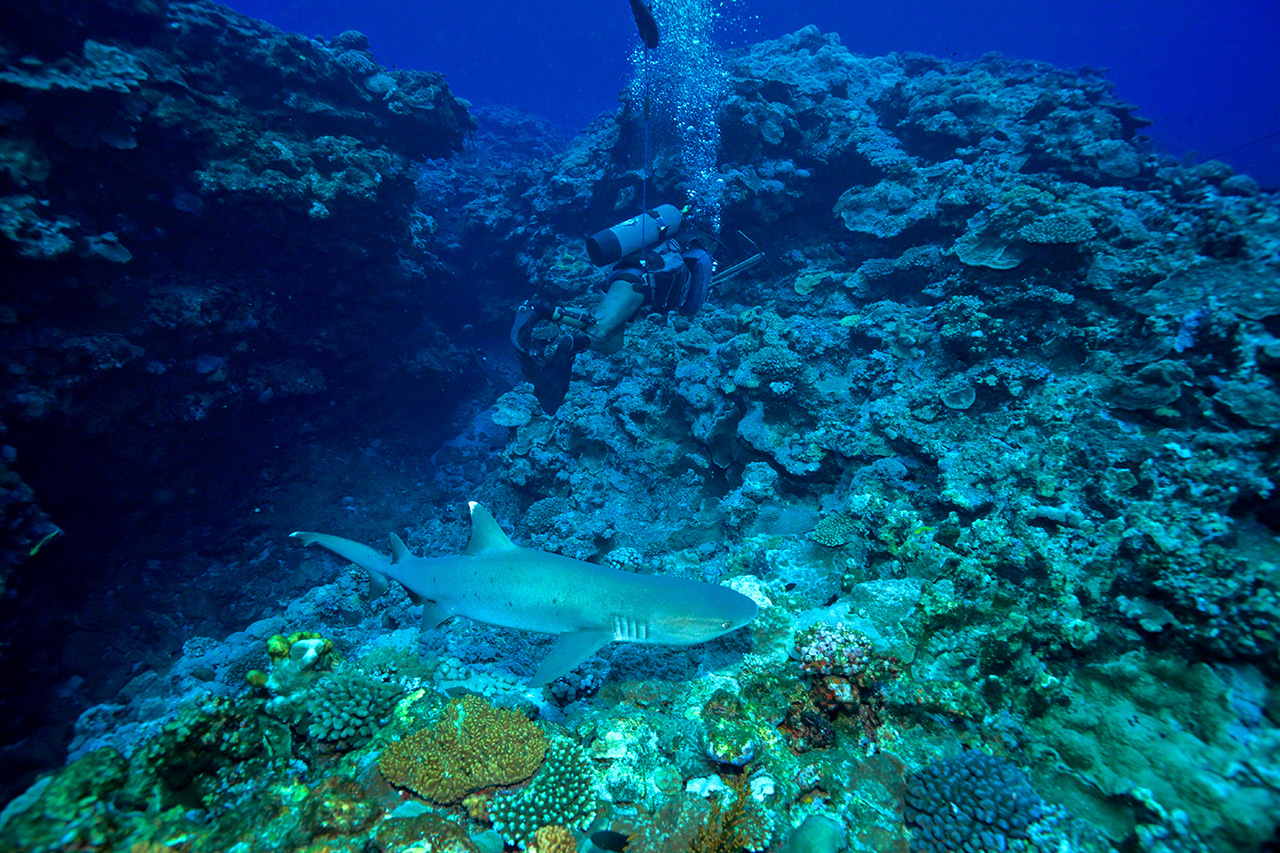
A reef shark attracted by the smell of the blood of a speared fish. Sharks and many other dangerous predators frequent the waters used by divers. (© Nishino Yoshinori)
“You have to watch the fish’s eyes while approaching and not make any unnecessary movements,” explains Uminchu. “If you watch the fish’s eyes, you can tell how wary it is of you.”
Uminchu doesn’t talk much about his work. To experts such as him, readily disclosing the secrets that they obtained by carefully observing those that came before them and through long years of experience would mean that all that effort would have been for nothing. Although this meant that repeatedly interviewing Uminchu was of great value, I also sensed that the meager knowledge that I gained from our interviews barely scratched the surface of this deep and profound walk of life.
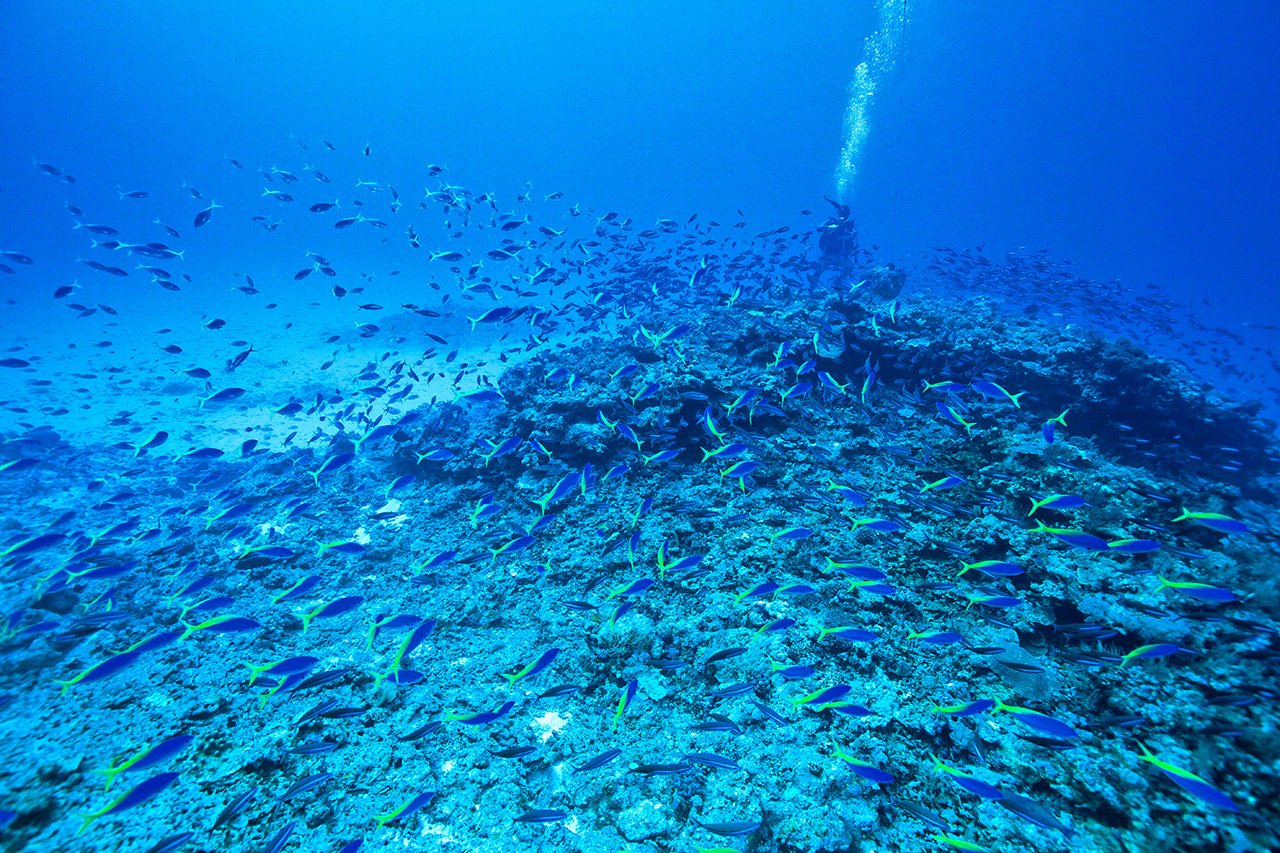
Surrounded by yellow and blueback fusilier, a type of double-lined fusilier, at a depth of 30 meters. (© Nishino Yoshinori)
Life or Death Decisions
I once accompanied Uminchu on a trip to Naka-no-Uganjima, a solitary island far out in the sea approximately 15 kilometers southwest of Iriomote. There are many knolls and banks in the seabed around the island where the water is shallower, which makes it an excellent place for catching large amounts of fish, including large specimens. But the strong currents and the surface whirlpools that they create make diving more dangerous.
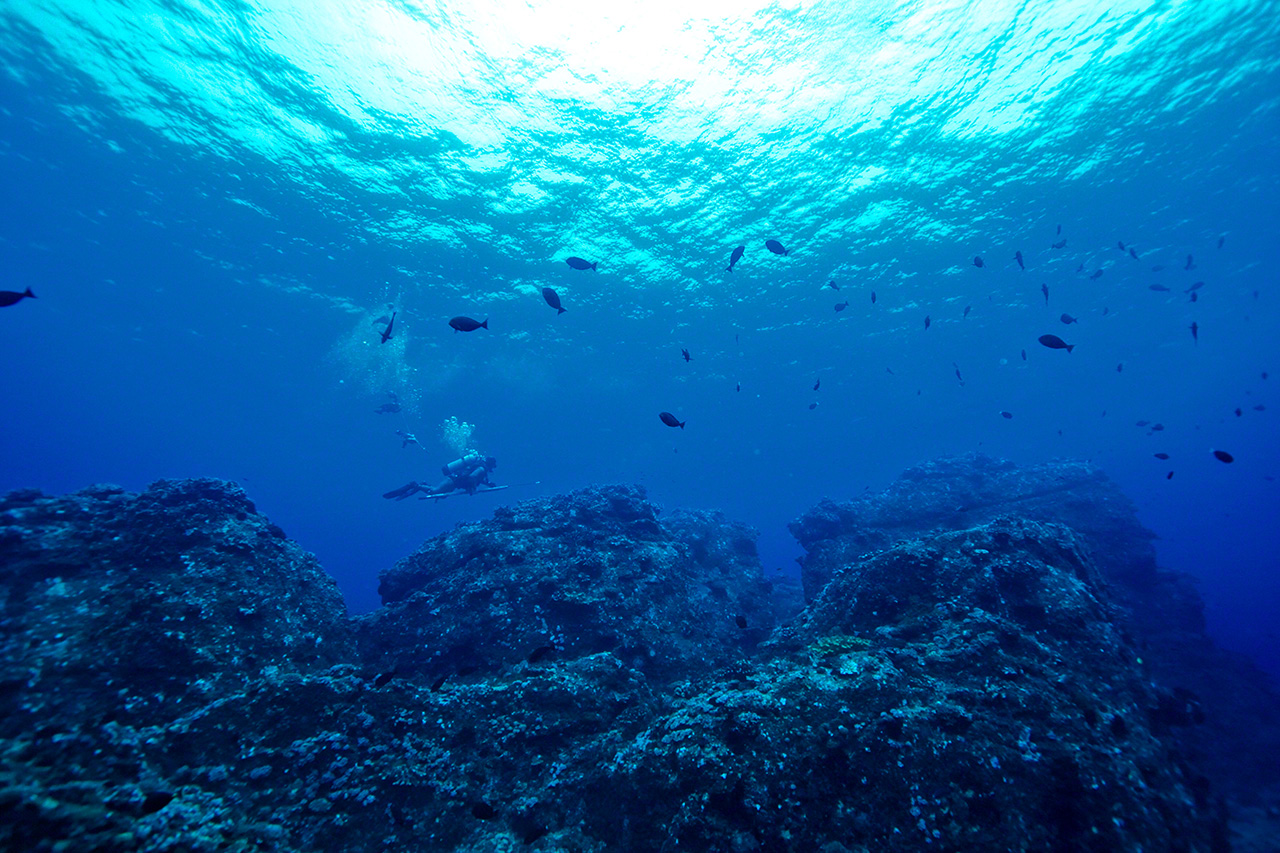
The waters near Naka-no-Uganjima. There are many game fish here due to the strong currents and complex sea floor topography. (© Nishino Yoshinori)
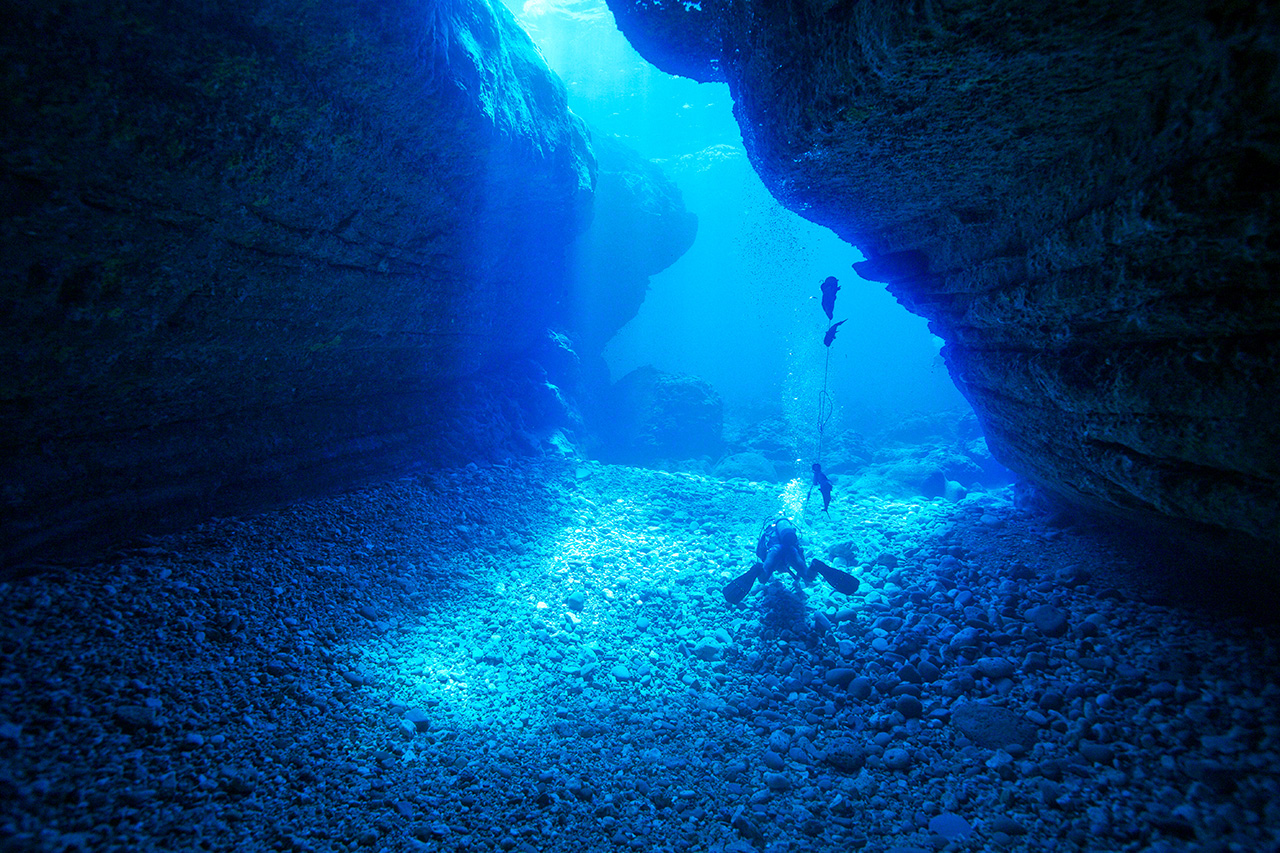
An undersea cave in the waters nears Naka-no-Uganjima. Large fish in the grouper family inhabit the deeper parts of the cave. (© Nishino Yoshinori)
On this particular day the currents were strong. We entered the water intending to swiftly reach a depth of 25 meters and then make our catch as quickly as possible before resurfacing. We were to communicate using hand gestures and with our eyes.
“There’s a big red spotted rockcod. We’ll go back to the boat after spearing it.”
Through eye-contact and gestures we were to relate this sort of thing to each other and plan our actions. But the current was stronger than we had anticipated, and we quickly found that the only way to move forward against it was to pull ourselves along by grasping on rocks. There was no way he would be able to spear fish, and taking photographs was completely out of the question. In fact, the underwater camera I had brought on the dive was acting as a drag on me and at one point I resigned myself to the possibility that I might have to ditch it. Uminchu calmly waited for an opportunity to surface. If he didn’t accurately determine the speed and direction of the current, we might never get back to the boat. Coordinating our movements like clockwork, we simultaneously left the ocean floor, which sped away from us as the current carried us along. And finally I managed to crawl back into the boat.
“That was pretty harrowing, wasn’t it?” Uminchu said. “Did your family members’ faces flash before your eyes?” he continued with a laugh.
I admired him for the inner strength that allowed him to face danger without flinching and for the dignity he displayed in laughing everything off as if it were nothing. I felt as though I had caught a fleeting glimpse of the true character of a diver who lived in the wild.
A Keen Business Sense
When in the water, Uminchu uses his diving fins like the dorsal and tail fins of a fish. When he spears a fish, he strikes with his entire body, as if a tightly coiled spring has suddenly been released.
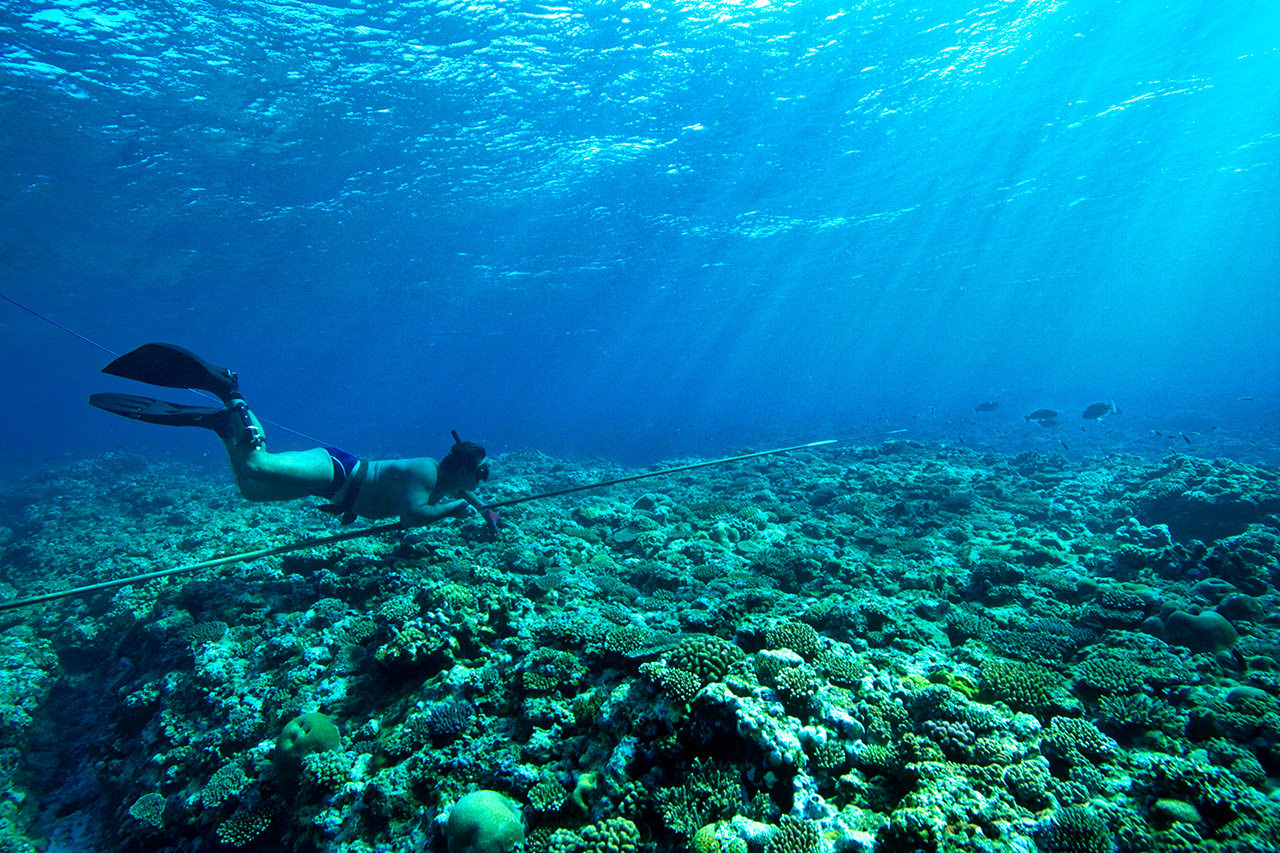
Uminchu uses his swim fins like pectoral fins to make fine adjustments to his movements in order to stealthily approach fish. (© Nishino Yoshinori)
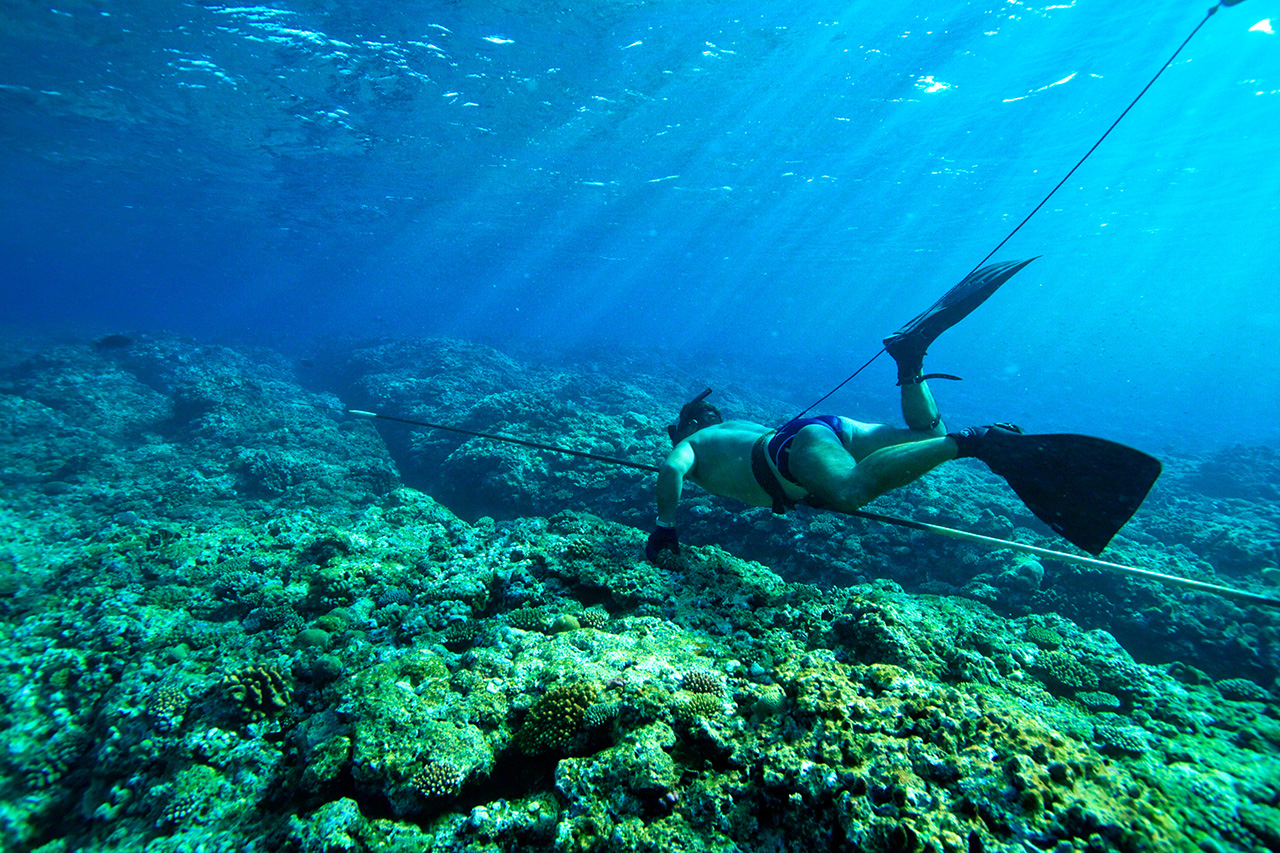
When pursuing fast fish, Uminchu uses his fins like the tail fins of a fish to give him speed. (© Nishino Yoshinori)
When Uminchu grapples with large fish weighing several dozen kilograms, the scene is literally that of a hunter of wild animals pitting his own strength against that of his prey.
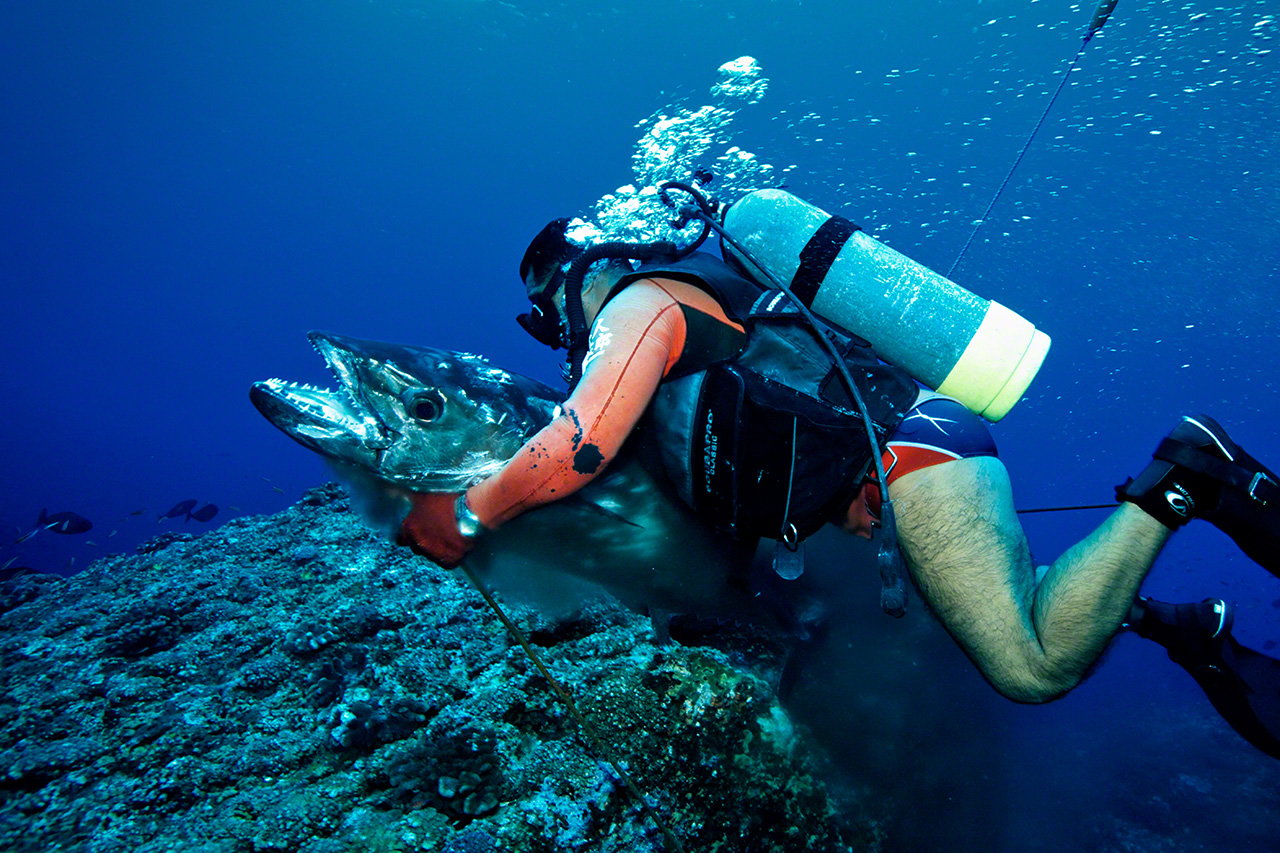
Grappling with a 45-kilogram dogtooth tuna. A fish this size has the strength to drag an adult human to the sea floor. (© Nishino Yoshinori)
At the same time, when eyeing possible prey, he considers the likely price he can get for it, as well as how difficult it may be to catch the fish. To do this, he must be able to determine the type of fish and many other factors in an instant. As the fishing industry continues to suffer due the rising cost of fuel and the consistently low prices at which catches must be sold, Uminchu needs to have a keen business sense. These days a diver cannot make a living on his skills and physical strength alone.
The divers of Ishigaki are constantly adopting modern conveniences as well. These include swimming fins, wetsuits, surface-supplied diving with air pumped down from compressors stored on board their boats, and scuba diving. Thus, traditional fishing remains viable even today because it is gradually changing as a result of the introduction of technological innovations that keep it competitive in today’s market.
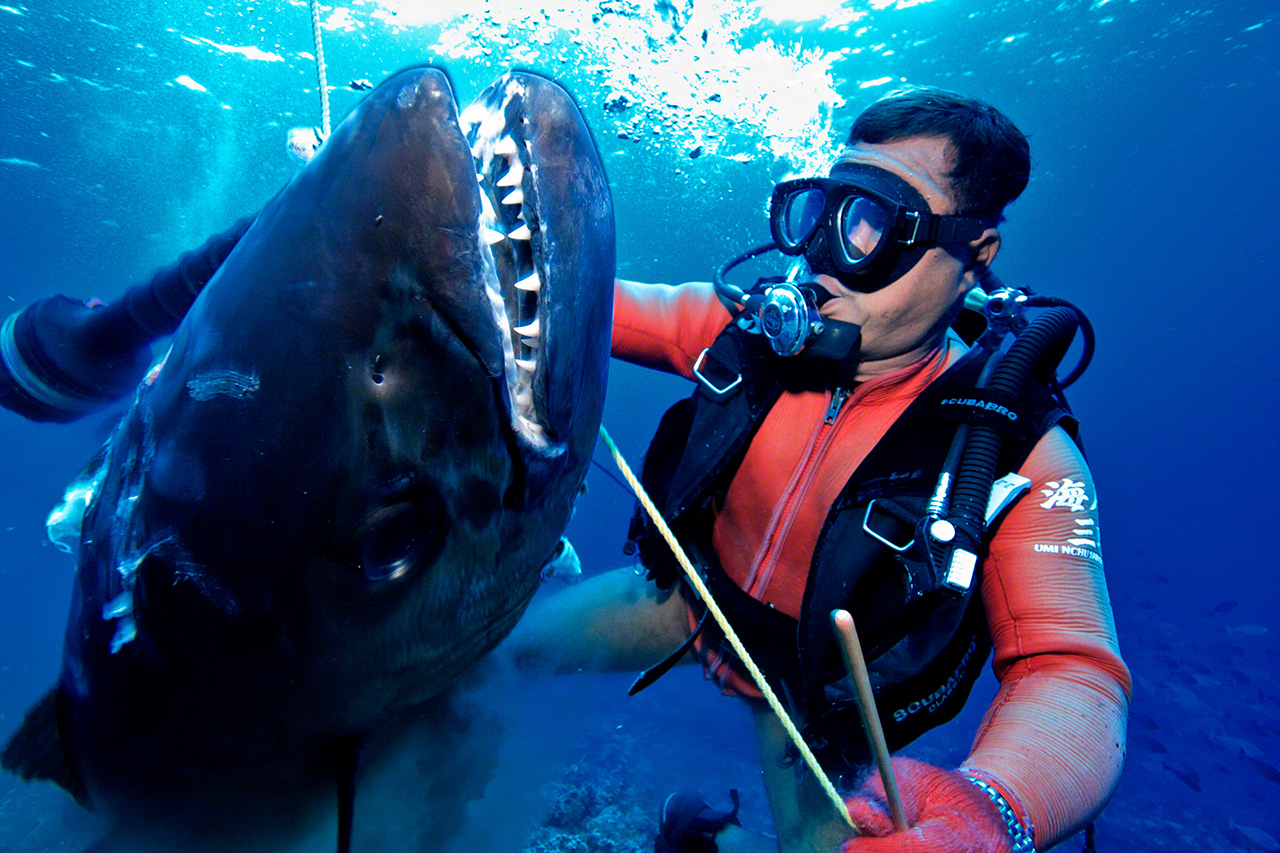
Catching a dogtooth tuna. As these fish inhabit the deeper parts of the ocean, divers use scuba gear or surface-supplied air. (© Nishino Yoshinori)
Nevertheless, in Okinawa several traditional fishing methods have been phased out over the last 20 years, meaning that the number of fishing techniques still available to divers is on the decline. Nowadays, younger fishermen have focused on aquatic cultivation of a brown algae known as mozuku and pole-and-line fishing for tuna, both of which are economically productive and based on firmly established techniques.
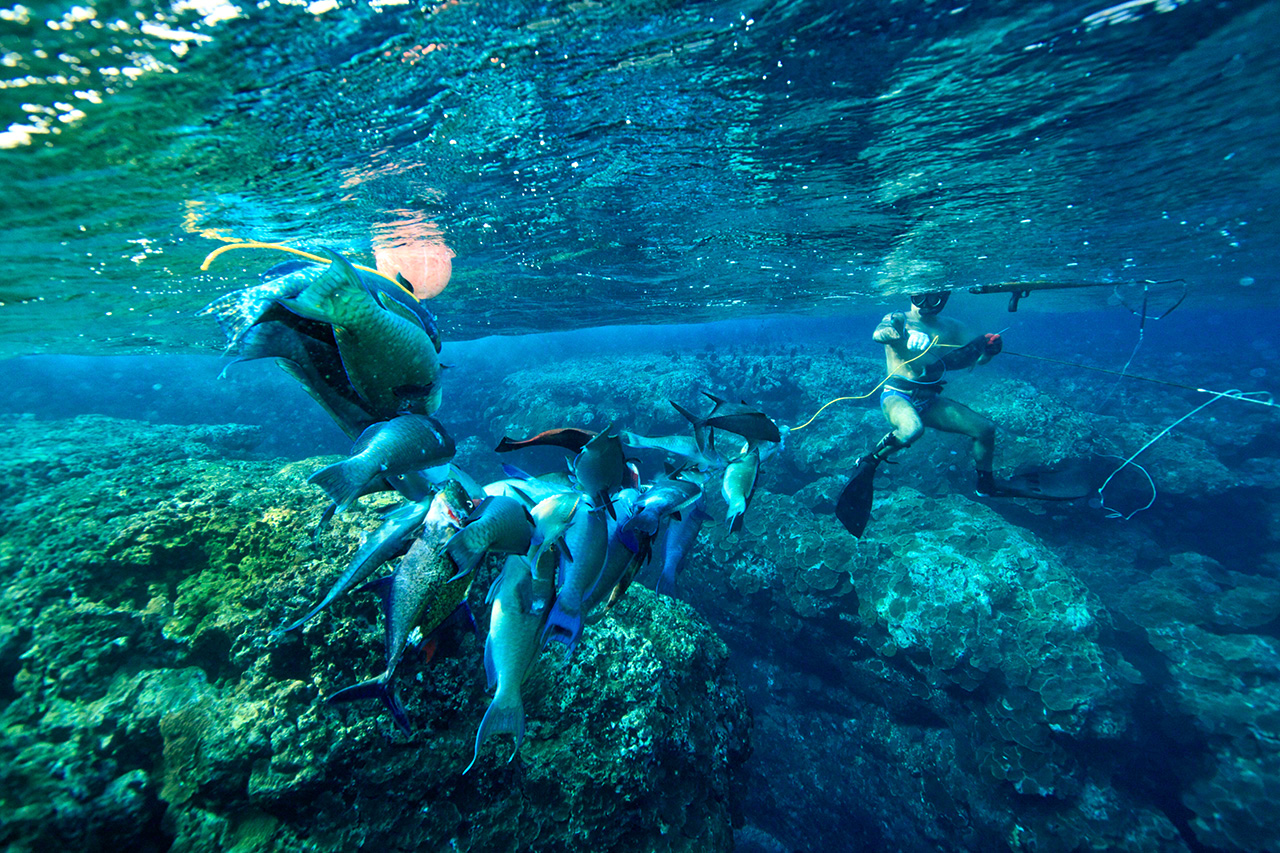
Large irabuchā strung together on a line. The fish shown here are an hour’s catch. (© Nishino Yoshinori)
As a result of these changes, Uminchu stands out to me all the more as a person who is the literal embodiment of the primitive people who once inhabited this region. As he continues to revitalize the untamed wildness that has receded from urban life, I will continue to follow him in an attempt to understand that elusive, decisive moment when he knows the time is right to thrust his spear into his prey.
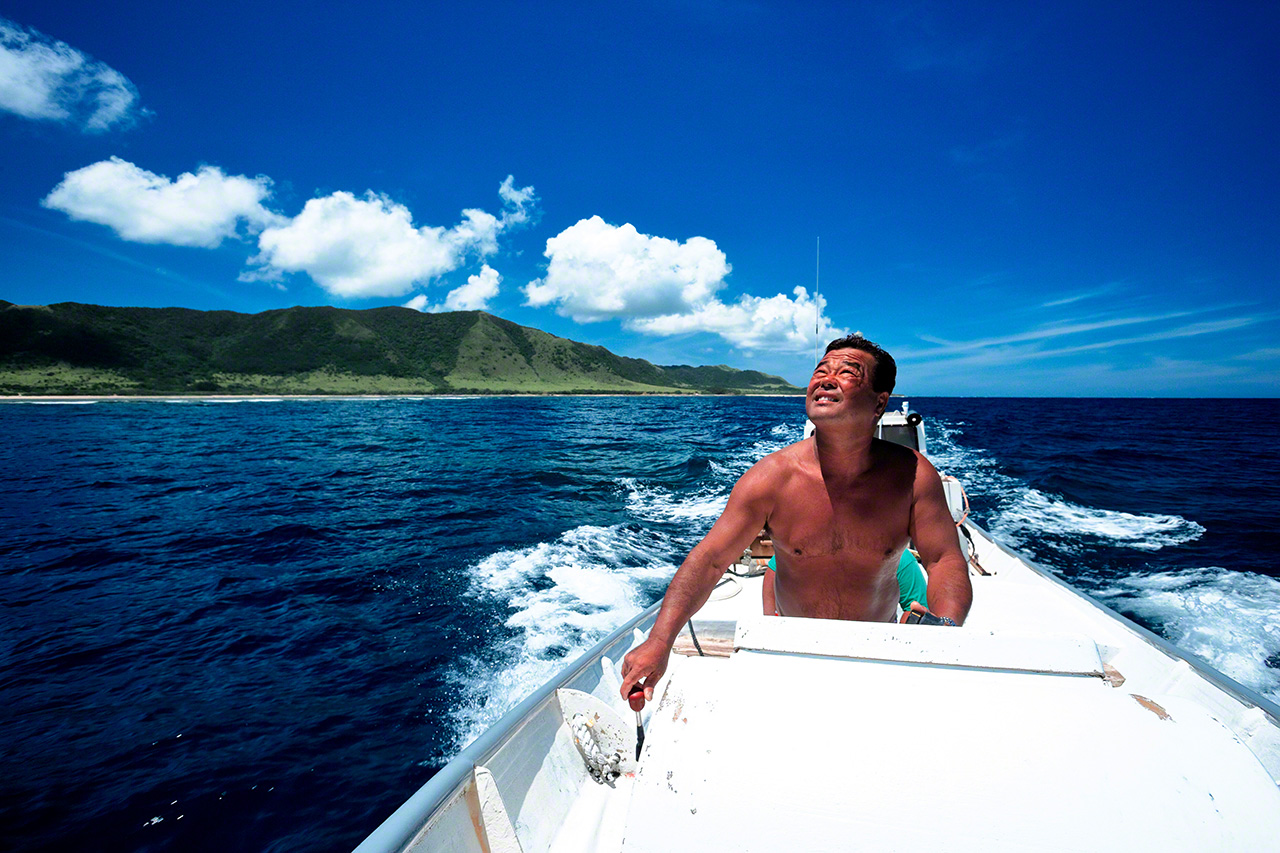
On the way back after fishing. Uminchu considers the coral reefs around the Yaeyama Islands and the open sea beyond to be his “workplace.” (© Nishino Yoshinori)
(Originally published in Japanese. Banner photo: Uminchu Saburō catching a 25-kilogram blacksaddled coral grouper in an undersea cave. © Nishino Yoshinori.)